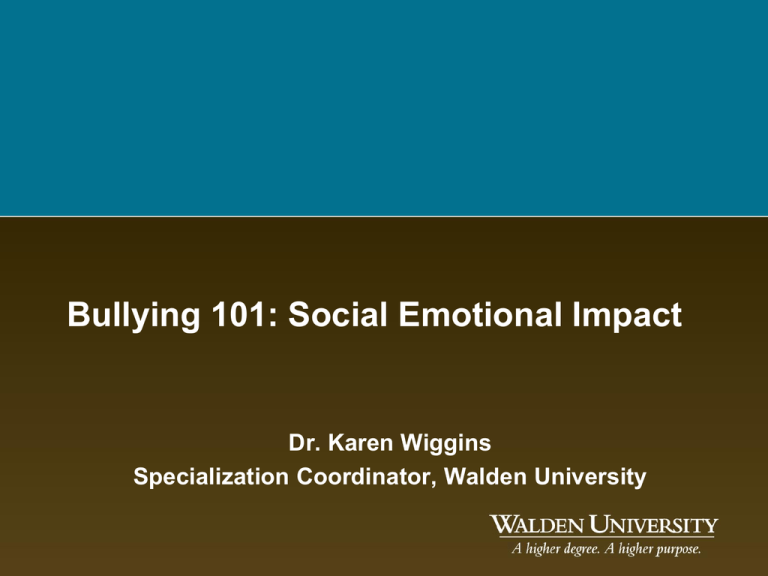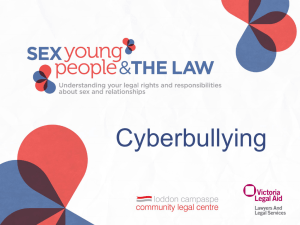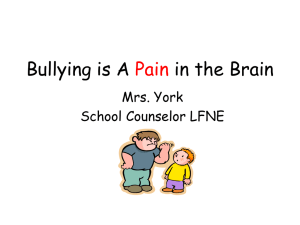Who Is a Bully?
advertisement

Bullying 101: Social Emotional Impact Dr. Karen Wiggins Specialization Coordinator, Walden University What Is Bullying? Pervasive Power imbalances Repetitive Clear intent to harm Causes lasting effects Four Types of Bullying Verbal Physical Bullying Cyber Social Who Is a Bully? Who Is a Bully? A bully can be any student. Gender does not determine who can be a bully. Possible Causes of Bullying Socioeconomic Poor academics* Peer rejection Kohut, 2007 Parental factors Home environment Characteristics of Bullies • • • • • Want to be popular Leader of their group Dominant Self-absorbed Do not accept responsibility for own actions • Crave attention Estevez, Murgui, and Musitu, 2009 Kohut, 2007 Types of Bullies • Confident – Big ego, likes violence, feels superior to others • Social – Prefers rumors and gossip, isolates victims, charming personality front • Fully Armored – Shows little emotion, bullies when cannot be seen or caught • Hyperactive – Poor social skills, struggles with homework, reacts aggressively Types of Bullies • Bunch of Bullies – Bully as a group, isolate and exclude target • Gang of Bullies – Formed based on power, dominate over others • Bullied Bully – Bullied by older kids and in turn bullies others How Female Bullies Typically Behave • Focus on the social types of bullying versus the physical • Can be more deceptive and malicious than boys • Typically lead a group of followers • Use body language such as eye rolling and sighing Garinger, 2006 Warning Signs That a Student Is Bullying Lack of remorse when harming others Intimidates, shuns, and ridicules others Obsessive interest in violence Verbal taunting Destroys others’ property Spreads gossip Must be center of attention Has no limits or boundaries Impulsive anger with authority figures Kohurt, 2007 Cyberbullying—Bullying in the Digital Age • Is your child a cyberbully? • What are some of the reasons why children resort to cyberbullying? Does your school address cyberbullying concerns? • Our school has developed disciplinary consequences for cyberbullying incidents. • Our school has a formal procedure for investigating incidents of cyberbullying. • Our school has an anonymous reporting system to address cyberbullying incidents. • Our students are taught how to recognize cyberbullying and threats to their online safety. • Our students are taught how to respond to cyberbullying in an appropriate manner. • We know how many students at our school have been victims of cyberbullying and how many have cyberbullied others. Who Is At Risk for Being Bullied? Characteristics of the Bullied Victim • Physically weaker than peers • Sensitive and withdrawn • Negative self-image • May look different than average peer • Lacks friends and social skills • Often raised in overprotective household http://pathwayscourses.samhas.gov/bully/bully_2_pg8.htm http://www.sadd.org/issues_bullying_know.htm Warning Signs That a Student Is Being Bullied Develops excuses to not go to school Steal money from parents Develops physical complaints Drop in academic performance Withdrawn and quiet Does not talk about school Isolated from friends Loss of appetite Stays close to teacher Kohurt, 2007 How They Are Being Bullied One-third of teens reported being bullied at school. Percent 20% 18% 11% 6% 5% 4% 4% Type of Bullying Made fun of Rumors or gossip spread about them Physically bullied Threatened Excluded from activities Coerced into something they didn’t want to do Personal belongings destroyed http://www.bullyingstatistics.org/content/bullying-statistics-2009.html Where Is Bullying Prevalent? 20% Elementary school High school Middle school Middle school 44% High school Elementary school 20% 0% 10% 20% 30% 40% 50% http://www.bullyingstatistics.org/content/bullying-statistics-2009.html Impact of Bullying Anxiety Bullying is serious and can have a wideranging, longterm impact. Depression Suicide Fear Revenge Strategies for Educators and Parents Strategies for Educators • Adopt an anti-bullying policy. • Require training. • Support and endorse student efforts. • Endorse inclusive curricula. If You Think Your Student Is … Being Bullied: Bullying: • Talk and empathize with the student. • Find solutions and resources together. • Document ongoing bullying. • Follow school policies. • Seek help from a school counselor. • Talk, listen, and remain objective. • Explain your zero-tolerance policy. • Spend time with him or her and monitor behavior. • Foster positive characteristics. • Follow school policies. • Work with a school counselor. Scenarios- What Would You Do? Chester, a tall, skinny teenager who excels in math and science classes, feels embarrassed when he has to change into gym clothes in the boy’s locker room at school because he lacks muscularity and size. Other, more athletic and well built teens notice Chester’s shyness and decide to exploit it. With their camera enabled cellular phones, they covertly take pictures of Chester without his shirt on and in his boxer shorts. These pictures are then circulated among the rest of the student body via cellular phone. Soon enough, boys and girls are pointing, snickering, and laughing at Chester as he walks down the school hallways. He overhears comments such as “There goes Bird Chested Chester” and “WussyBoy” and “ChickenLegs Chester” and “Stick Boy.” These words cut him deeply, and the perception that his classmates have of him begins to affect his math and science grades. Scenarios If you were his teacher, what would you do? If you were his parent, what would you do? What can Chester do to deal with the harassment—now and in the future? How can his harassing classmates really understand how much pain they are causing with their words and actions? What would you do if you were a bystander? Scenarios Two female sixth graders, Katie and Sarah, are exchanging malicious instant messages back and forth because of a misunderstanding involving a boy named Jacob. The statements escalate in viciousness from trivial name calling to very vicious and inflammatory statements, including death threats. Scenarios Should the police be contacted? Are both girls wrong? What should the kids do in this instance? What would you do as a parent if you discovered this problem? What might a school counselor do? What should a teacher do? Cyberbullying Research Center www.cyberbullying.us Strategies for Parents • Be aware. • Communicate. • Assess your own behavior. • Encourage confidence. • Teach your child about bullying. • Provide resources. If You Think Your Child Is … Being Bullied: Bullying: • Talk and empathize with them. • Find solutions and resources together. • Document ongoing bullying. • Seek help from a school counselor. • Seek help from a mental health professional. • Talk, listen, and remain objective. • Explain your zero-tolerance policy. • Spend time with him or her and monitor behavior. • Know his or her friends. • Work with a school counselor. • Seek help from a mental health professional. Parental advice for Cyberbullying Remember I-CURRB Investigate what your child is doing online Communicate with your child. Use family safety software to keep track of what your child is doing online. Research your school’s and ISP’s policy on cyberbullying. Report cyberbullying to your child’s school and ISP. Block communication from cyberbullies. Educators and Our Interaction With Bullies Are you a Bully or an Educator? Educators let students know they care. Bullies let students know who is the boss. Educators teach self-control. Bullies exert their own control. Educators diffuse minor disruptions with humor. Bullies use sarcasm to turn disruptions into confrontations. Bully or Educator? Educators help all students feel successful. Bullies attack the character of the misbehavers. Educators see each student’s uniqueness. Bullies compare children to one another. Educators treat all students with respect. Bullies make it clear that not all students deserve respect. http://www.youtube.com/watch?v=E6lH_SPD2gk Through the eyes of a child http://www.youtube.com/watch?v=E6lH_SPD2 gk Questions ? Thank you for attending. karen.wiggins@waldenu.edu







